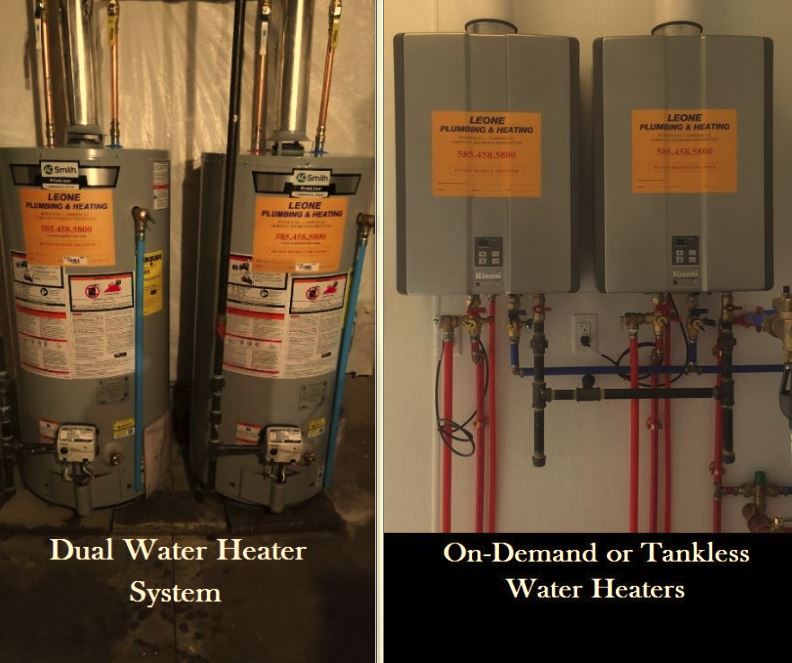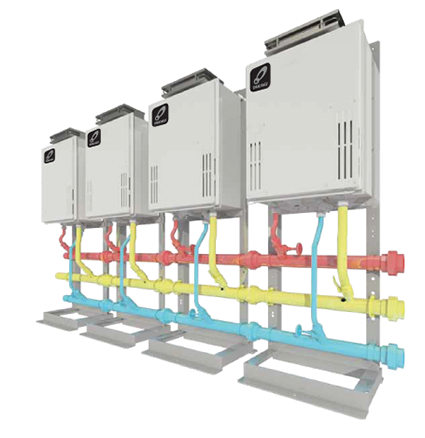Yes, you can put two tankless water heaters together. This setup can provide increased hot water supply for larger households.
Tankless water heaters offer an efficient way to supply hot water on demand. They heat water directly without using a storage tank. Combining two units can enhance performance, especially in homes with high hot water needs. This setup minimizes wait times for hot water and reduces the risk of running out.
It’s essential to consider proper installation and compatibility to ensure optimal performance. Properly sizing the units and plumbing configurations can maximize efficiency. For homeowners seeking reliable hot water solutions, using multiple tankless heaters can be a practical choice. Always consult a professional for the best results and safety.

Credit: www.wilsonvilleplumbing.com
Page Contents
Introduction To Tankless Water Heaters
Tankless water heaters provide hot water on demand. They heat water directly without a storage tank. This means you save energy since water isn’t heated all day.
Benefits of going tankless include lower energy bills and endless hot water. They are compact and save space in your home. These systems are also more durable than traditional heaters.
With tankless heaters, the flow rate is important. This determines how much hot water you can use at once. Multiple units can be connected for greater demand.
How tankless water heaters work involves heating elements activated by water flow. When you turn on a tap, cold water travels through a pipe into the unit. A heating element warms the water instantly.
The Concept Of Doubling Up
Using two tankless water heaters can be a smart choice. It provides greater hot water capacity. This setup can meet the needs of larger homes. Two units allow for better efficiency and reduced wait times.
Parallel installation means both units work at the same time. This setup shares the load equally. It ensures hot water is available quickly. Series installation makes one unit heat water first. The second unit boosts the temperature further.
Choosing the right installation method depends on your needs. For high demand, parallel installation is often best. For specific heating requirements, series installation may be better.
Assessing Your Hot Water Needs
Understanding your hot water needs is crucial. Start by calculating demand for hot water. Determine how many appliances will use hot water at the same time. This includes showers, dishwashers, and washing machines.
Sizing tankless systems properly ensures efficiency. Each tankless unit has a flow rate, measured in gallons per minute (GPM). Check the GPM of each appliance to find the total needed. Multiply the GPM by the number of simultaneous uses to get the overall demand.
| Appliance | GPM |
|---|---|
| Shower | 2.5 |
| Dishwasher | 1.5 |
| Washing Machine | 2.0 |
| Total Demand | 6.0 |
Consider the total demand when choosing two tankless water heaters. This will help provide enough hot water for your home.
Need Local Help?
Fast, Reliable Water Heater Service
Whether it’s installation, repair, or replacement, connect with a trusted local expert today. From fixing leaks and heating issues, we’ve got you covered.
Simply choose your service type in the form, share your details, and a certified water heater specialist will contact you shortly!
Smart Water Source is an informational platform that helps users connect with local plumbers. We do not directly provide plumbing services or operate as a licensed contractor.
Installation Insights
Installing two tankless water heaters can save space and energy. Make sure there is enough room for both units. They need proper ventilation and access for maintenance.
Plumbing adjustments may be necessary. Connect the heaters to the same water supply. Ensure that pipes can handle the increased flow rate. It’s vital to have a qualified plumber check your setup.
| Consideration | Details |
|---|---|
| Space | Ensure enough room for two units. |
| Ventilation | Both units require proper airflow. |
| Plumbing | Adjust pipes for increased water flow. |
| Expert Help | Consult a qualified plumber for installation. |
Cost Implications
The initial investment for two tankless water heaters can be significant. Costs include the heaters, installation, and necessary plumbing upgrades. Expect to spend more upfront than a single unit.
On the flip side, long-term savings can be substantial. Tankless heaters are more efficient than traditional models. They use less energy and provide hot water on demand.
With reduced energy bills, homeowners often see savings over time. This can make the higher initial costs worthwhile. Investing in two units may lead to better performance and greater energy efficiency.

Credit: www.leoneservice.com
Performance Factors
Using two tankless water heaters can improve overall performance. This setup helps increase the flow rate, allowing for more hot water. Ideal for larger homes, it meets the demands of multiple fixtures.
Temperature consistency is also enhanced with two units. Each heater can share the workload. This reduces the chance of fluctuating temperatures during use. Enjoying a hot shower becomes more reliable and comfortable.
| Performance Factor | Benefit |
|---|---|
| Flow Rate Enhancement | More hot water for multiple outlets |
| Temperature Consistency | Stable water temperature during use |
Maintenance Matters
Maintaining multiple tankless water heaters is essential for optimal performance. Regular cleaning and inspection help to avoid problems. Check for mineral buildup every few months. This buildup can lead to decreased efficiency.
Ensure proper ventilation for each unit. This prevents overheating and improves safety. Always check the filters and replace them as needed. A clean filter ensures better water flow.
Common issues include fluctuating temperatures and low water pressure. These problems can often be fixed with simple adjustments. Inspect the thermostats and reset them if necessary. For persistent issues, consult a professional.

Credit: www.takagi.com
Case Studies
Many homeowners benefit from using two tankless water heaters together. This setup provides a steady flow of hot water for larger households. One heater can handle the kitchen and bathrooms, while the other serves laundry and dishwashing. This arrangement reduces waiting times for hot water.
In commercial settings, businesses enjoy significant advantages from dual tankless systems. Restaurants often require constant hot water for cooking and cleaning. A second heater ensures that all demands are met without interruption. This solution is efficient and cost-effective in the long run.
| Application | Benefits |
|---|---|
| Residential | Steady hot water for large families |
| Commercial | Consistent supply for high-demand businesses |
Making The Decision
Choosing to install two tankless water heaters can have great benefits. It offers endless hot water for large families or businesses. However, installation costs may rise. Maintenance also becomes more complex with two units.
One major advantage is energy efficiency. Tankless heaters use less energy than traditional ones. They only heat water when needed. On the flip side, space requirements may increase. Finding room for both units can be a challenge.
Consulting with professionals is crucial. They can assess your plumbing system and space. An expert can help you decide on the best setup. Always check for local codes and regulations before installation.
Future Of Home Heating
Tankless water heaters are becoming popular for many homes. They save energy by heating water only when needed. Innovations in tankless technology focus on efficiency and sustainability.
New designs use advanced materials for better performance. Some models can be connected for larger hot water needs. Smart technology allows users to control temperatures easily. This can reduce energy waste and costs.
The environmental impact is significant. Less energy use means fewer emissions. Choosing tankless systems supports a greener planet. Homeowners can feel good about their choices.
| Innovation | Benefit |
|---|---|
| Advanced Materials | Improved efficiency |
| Smart Technology | Easy temperature control |
| Connected Systems | More hot water |
Conclusion
Combining two tankless water heaters can be a smart solution for increased hot water demand. It’s essential to ensure proper installation and compatibility for optimal performance. Consulting with a professional can help you navigate this process. With the right setup, you can enjoy endless hot water for your home.
